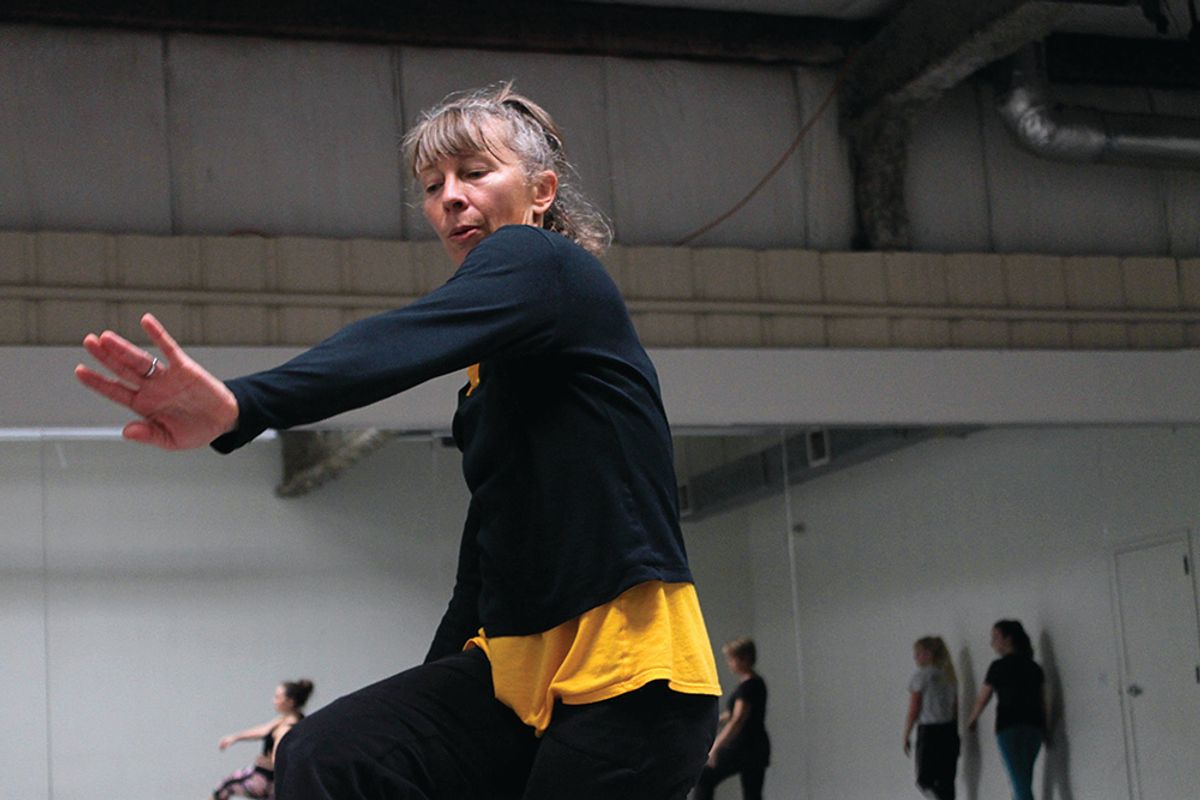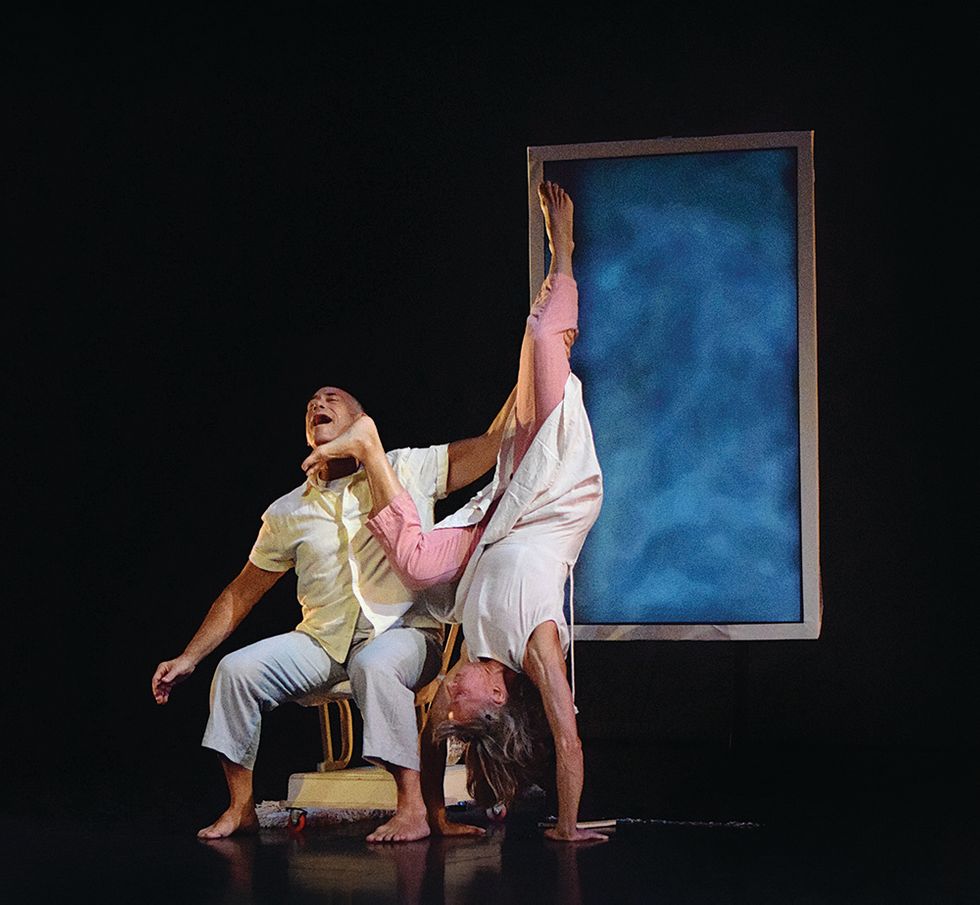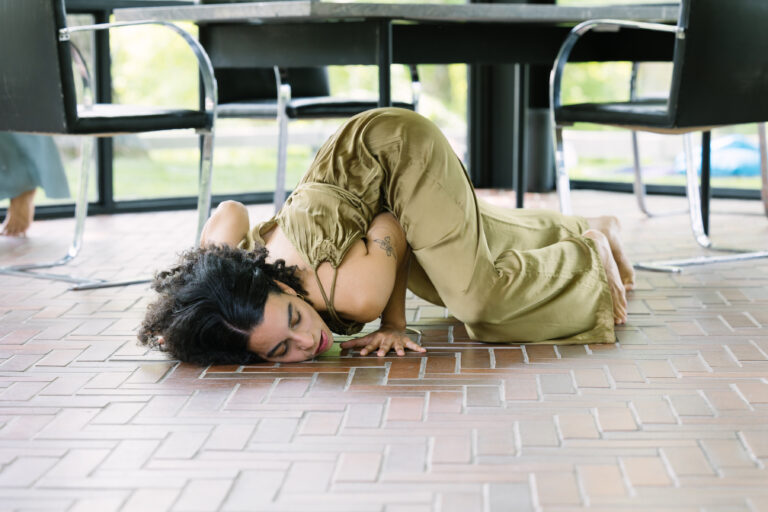
Growing up in New Jersey, Lisa Race trained with a memorable dance teacher: Fred Kelly, the younger brother of famous tapper Gene. “Fred would introduce our recitals,” she says. “He would always cartwheel down the stairs.” It wasn’t until years later, when Race was pursuing her master’s degree and chose to write a research paper on Kelly, that she realized there was a clear connection between her own movement style—improvisational and floor-based—and his. “In this television clip I watched, Fred jumps up to the piano, then jumps off it—he’s going up and down and around,” she says. “I thought, ‘Oh, wow, all this time, I’ve thought of my dancing as my own, but that’s where it started!’ Moving upside-down and into the floor. There’s a thread there. I rerouted it in different ways, but there’s a connection.”
Now, as a professor at Connecticut College, she concentrates on how to introduce her students to that love and freedom of upside-down work—and how to best prepare them for life after graduation, no matter what dance path they take.
On not flailing
Race discovered modern dance at Rutgers University and quickly fell in love. “I first learned about Limón and Laban and Humphrey-Weidman and found spiral and floor,” she says. “I thought, ‘This is interesting to me.'” But after moving to New York City upon graduation, she felt lost. “I would go to auditions and try to look exactly like the person giving the material—and I would always flail,” she says. She held brief company or apprentice stints with a few choreographers—Bill T. Jones, Ronald K. Brown, Sara Pearson/Patrik Widrig—but it wasn’t until she attended an audition for David Dorfman that she truly managed to be herself.
She’d met Dorfman at a performance in Central Park, and after seeing her perform a few months later, he asked her to attend a company audition. “I did it reluctantly,” Race says, “because I was terrible at auditions. But somehow I went, and I said to myself, ‘Be yourself. Don’t do other people. Do you.'” That, she says, “seemed to be the right approach.”
She got the job and danced with Dorfman’s company for 11 years. Toward the end of her tenure with the company, she and Dorfman began dating. They’ve now been married for 16 years and have a teenage son, Sam.
Race’s teaching path was similarly meandering. Her first teaching gig happened by accident, when someone canceled at Movement Research in New York City and Race happened to be around and available. “I was really about trial and error,” she says. “Early on, I taught so many phrases. One of my learning curves and processes has been trying to understand what I want people to get from classes and take the time to develop that.” When Dorfman accepted a teaching position at Connecticut College, Race joined him first as a guest artist, officially signing on as full-time professor in 2007.
Making friends with the floor
The time Race spent in Dorfman’s company has informed much of her approach to teaching. “I think a lot about how a contact-improvisation–based form of partnering was a part of that work,” she says. “And I did a lot of gymnastics as a kid. So my desire to go upside-down has been a root of my teaching.” Inversion work—in which dancers lift their lower halves above their upper bodies, using hands and arms to support themselves—can be a scary element of modern dance for many college freshmen. “Students tend to come in with a strong sense of verticality,” says Race. “I’m trying to instill a confidence in them to dance with their entire bodies—to think about the whole kinesphere that surrounds you, so you’re ready to move into the space above, below, behind, beside you. A large part of that is being really comfortable with the floor as your first partner.”
Race tries to make the transition from right-side-up to upside-down as intuitive as possible. Rather than asking dancers to start with their arms up over their heads and then reverse their entire bodies all at once (the way many are first taught a handstand, for example), she stresses using an under-curve—bending the legs from an upright position and gradually curving the top half of the body down toward the floor. Upside-down work isn’t about holding a static position with your legs over your head, for Race. “It’s a place to play with suspension and then come down,” she says. “What’s it like to use that under-curve to get your hands on the ground and reach through the leg but not really go off the floor? Then, we use that to develop the confidence to go a little bit further.”

Race performing with David Dorfman in Mid-Tide, which premiered at Connecticut College last year.Photo by Lauren Cress, courtesy of Connecticut College
An evolving curriculum
As the landscape of what it means to dance professionally evolves, Race and the rest of the faculty at Connecticut College are committed to holistically preparing undergrads for life after college. “We’re finding ways to allow all dance forms to be equal and relevant to the major,” she says. Connecticut’s past model had first-year majors attending a modern technique class three days a week and a ballet class twice a week. “This fall,” she says, “they’ll have a three-day course that will rotate each week, so that all of our modern teachers will teach a week, but so will our Afro-Caribbean teacher, and so will our West African teacher, and we’ll probably have a hip-hop teacher.” The idea is to give students more of an introduction to different forms right away, so that they can “contextualize the connections between dance forms and the cultural differences,” says Race. Students can then choose if they want to focus, for example, on West African or improvisation.
Race is also teaching a new class in the fall: dance pedagogy. “For the students who want to dance professionally,” she says, “it’s really important to offer a dance pedagogy class,” so that they can supplement their careers with teaching jobs. It’s also a way to give back to the community in New London, Connecticut, she says, and she’s in the process of trying to set up a dance program within local schools to give undergrads teaching experience.




